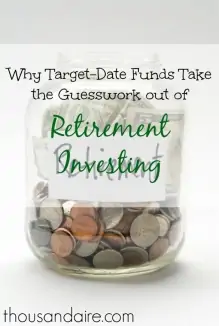Target-Date Funds are a big topic in mutual funds right now, for investors and fund companies alike. Investors see them as a one-stop shop for retirement investing. Fund companies have found target-date funds to be a gold mine. Morningstar reports that target date funds account for one third of investment flows for companies that offer them.
The concept of a target-date fund is fairly simple. Funds are categorized by year of retirement, and their asset mix reflects the amount of time before that date. For example, funds targeting retirement in 2050 are most likely invested in more stocks, theoretically giving them more return potential than funds targeting 2025, which would likely be weighted towards more conservative investments, such as investment grade bonds.
Look beyond retirement date
Estimating your retirement year is simple enough, but it isn’t the only consideration in choosing a target-date fund. The composition of a one company’s fund may differ dramatically from that of another company’s, even though they ostensibly target the same retirement year.
The formula for transitioning the portfolio from equities to bonds is called the fund’s glide path, and it is determined entirely by the investment manager’s philosophy. For example, some funds transition almost entirely to bonds, or even cash, as the retirement date nears, in order to protect the portfolio from short term market swings. Others maintain an equity allocation right up to, and sometimes beyond, the retirement date. Likewise, some portfolios remain static after the retirement date, while others continue to shift their allocations beyond retirement.

Choosing a target-date fund
Every glide path comes with its own level of risk. How you choose a fund depends on your level of involvement with your investments. For example, if you find the idea of risk/return profiles relative to stocks and bonds mind-numbingly boring, you may want to choose based on your own risk category – conservative, moderate or aggressive. Rather than immersing yourself in the details of asset allocation, you can simply look at the fund’s risk relative to its benchmark index, and choose based on your own risk tolerance. If you have believe that only a fool would be invested in stocks past age 50, you should probably look for a fund whose glide path most closely reflects that belief.
Other considerations
Another aspect of target-date funds that bears consideration is expense. Since these are “funds of funds,” you need to factor in two layers of expense. The first is the cost of the target-date fund itself, and the second is the expense related to the underlying investments. As the asset mix changes in response to shrinking time horizon, the expense ratio may change to reflect the differing costs of the underlying funds.
Target-date funds are not for everyone. Once you make the initial investment in a target-date fund, you turn over the reigns. There is no phoning the portfolio manager to suggest a greater allocation to small caps, so if you like to tinker with your investments, you may want to think carefully about other options for all or part of your retirement savings.
A solid option for retirement investing
Overall, target-date funds are an option worth considering for retirement. A strategy that includes target-date funds can help to diversify your portfolio with investments that are reallocated automatically to suit your decreasing time horizon. Target-date funds can be used exclusively, if reallocating your own portfolio doesn’t appeal to you, or as part of a larger strategy that includes other investments.

